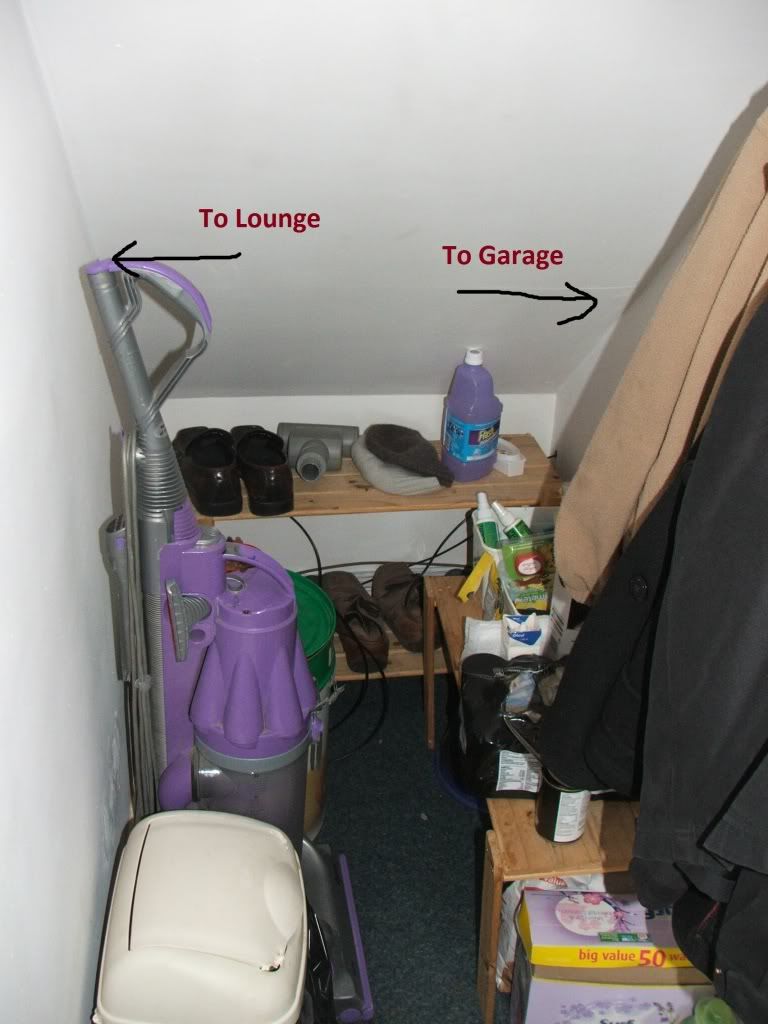Soldato
- Joined
- 11 Oct 2005
- Posts
- 5,718
- Location
- Derbyshire
Following on from my previous thread......
http://forums.overclockers.co.uk/showthread.php?t=18304205
I now have x2 Cat5e Solid cable runs from BT master Socket (fitted with ADSL Nation XTE-2005 faceplate)
One cable has been IDC punched into the A/B ADSL connectors on the back of said faceplate.
The other cable has been fitted next to master socket with a RJ45 wall outlet.
The cables all meet in this room under the stairs.
THIS is the area I need advice with.

where 'Lounge' is shown on photo that is the wall behind my AV Unit.
I have a Brush plate on that wall allowing me to route cables through from Understairs room to lounge.
Now at the moment Router is in lounge connected with a RJ11 crimped to Solid Cat5e that comes from master socket.
PS3/HTPC connected by ethernet to ports on router.
What do I need to do to sort all this wiring out under the stairs. Am I best of buying a patch panel, Do I need a 2 or 4 jack rj45 wall plate in lounge or routing cables through brush plate to router is ok?
Just don't know what best practice is now. To sort all this out.
Bit confusing to me.
Looking forward to some advice. Sorry for long post. I find this scenario hard to explain in words.
PS: This room, we, aka OCUK can do whatever we want in here. Most of the stuff can be shifted elsewhere in the house.
So. Spec away, advise.
Thanks
http://forums.overclockers.co.uk/showthread.php?t=18304205
I now have x2 Cat5e Solid cable runs from BT master Socket (fitted with ADSL Nation XTE-2005 faceplate)
One cable has been IDC punched into the A/B ADSL connectors on the back of said faceplate.
The other cable has been fitted next to master socket with a RJ45 wall outlet.
The cables all meet in this room under the stairs.
THIS is the area I need advice with.

where 'Lounge' is shown on photo that is the wall behind my AV Unit.
I have a Brush plate on that wall allowing me to route cables through from Understairs room to lounge.
Now at the moment Router is in lounge connected with a RJ11 crimped to Solid Cat5e that comes from master socket.
PS3/HTPC connected by ethernet to ports on router.
What do I need to do to sort all this wiring out under the stairs. Am I best of buying a patch panel, Do I need a 2 or 4 jack rj45 wall plate in lounge or routing cables through brush plate to router is ok?
Just don't know what best practice is now. To sort all this out.
Bit confusing to me.
Looking forward to some advice. Sorry for long post. I find this scenario hard to explain in words.
PS: This room, we, aka OCUK can do whatever we want in here. Most of the stuff can be shifted elsewhere in the house.
So. Spec away, advise.
Thanks
Last edited:




